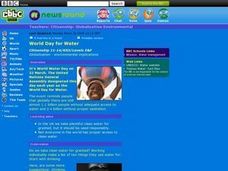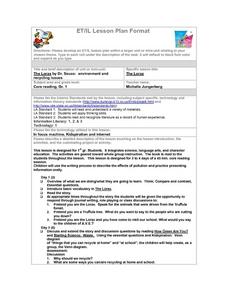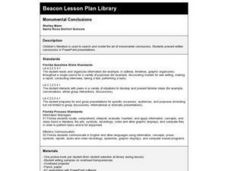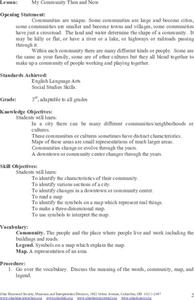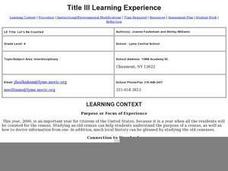Curated OER
Does the Seed Matter?
Students compare the growth of watermelon from commercial seeds and those harvested from a watermelon. They complete science journals showing these comparisons based on the data they collect.
Curated OER
Tools of the Historian: Frame of Reference
Students discuss the term point of reference and describe their own point of view. They compare the relationship between sources and the historical context. They identify examples of how point of reference can affect one's interpretation.
Curated OER
What's the Depth?
Students practice digital camera skills by identifying effects of depth of field at different apertures, comparing effects of depth of field with different focal lengths, and creating images showing effect of depth of field at different...
Curated OER
The Constitution
Students determine that the rules that we follow in America were written in the Constitution. They study a copy of the constitution and discuss how it compares and differentiates from the plan the class has written. They recite our...
Curated OER
Clean Water and World Water Day
Students investigate World Water Day in relation to clean water that should be used responsibly. They create lists of ten things they use water for and compare their answers in small groups. They research a documentary for World Water...
Curated OER
Environment and Recycling Issues
First graders read and understand the text found while conducting internet research. They recognize how literature records information and reflects the human experience. Students also compare and contrast answers to questions. Then...
Curated OER
And Around We Go!
Sixth graders conduct a survey and collect data to construct a bar graph that will then be changed into a circle graph. With the bar graph, 6th graders compare estimated fractions and percentages and estimate percentages. With the circle...
Curated OER
Society, Cyberspace and the Future
Young scholars locate information on the rapid growth of world population and consumption needs through the use of Internet, Cd-ROMs, laser dics and other media. They use spreadsheet to present data gathered on world population growth...
Curated OER
Science: Liquid Matter
Second graders examine the properties of liquids and their classifications. They compare and contrast cups of different liquids and record their findings in journals. Students observe how liquids flow at various speeds and that unlike...
Curated OER
Colonizing the Stars
Students compare and contrast the size, composition and surface features of the nine planets of our solar system with the possible sizes and compositions of extra -solar planets.
Curated OER
Video Umpires
Students play umpire in a baseball game. They video the umpire's calls and then examine the accuracy of a "line call" when compared to a taped record of a ball's exact impact location. They create a transcript of a fictional court case...
Curated OER
Energy and Fuels
Students compare and contrast the various energy resources available to the general population. Working in groups, they research the energy source of their choice and create a presentation detail their research and comparing their...
Curated OER
The Living Environment
Ninth graders compare and contrast animals according to their four systems. In this living environment lesson plan students complete their assignment on the animal they were given and present their findings to the class.
Curated OER
Day Five - Bible A Noble Cause - Thessalonica
Students analyze, compare and contrast success and failure inside the kingdom and outside the kingdom. In this Bible study lesson plan students read Act 17:1, plays games, engage in discussions and complete a written...
Curated OER
Get the Skinny on Milk
Students identify the different types of milk available in the market. In this adult health science activity, students compare their nutrition information. They read milk labels and analyze the nutrients in it.
Curated OER
Nonprofits?
Students distinguish the nonprofit sector from the for-profit sector. They define and give examples of nonprofit organizations, name and illustrate examples in the local community and compare and contrast nonprofits to the for-profit...
Curated OER
Exploring the Neighborhood -- Literature Jigsaw
Students compare and contrast domesticated animals and wild animals. They identify plants and animals that have adapted to different habitats. They discover it is everyone's responsibility to protect the environment.
Curated OER
Make Your Own "Weather" Map
Pupils create their own "weather" map using data from x-ray sources. They analyze and discuss why it is important to organize data in a fashion in which is easy to read. They compare and contrast different x-ray sources using a stellar map.
Curated OER
Monumental Conclusions
Fourth graders create a PowerPoint presentation comparing a "Grabless Conclusion" to a "Monumental Conclusion", using picture books.
Curated OER
Heavy Issues
Fourth graders compare the difference between the mass of people, vehicles and trains in order to explain why it is important not to trespass on railroad tracks.
Curated OER
Viciousness in "Twelfth Night" and "Lord of the Flies"
Young scholars work in discussion groups to examine the treatment of Malvolio in Shakespeare's "Twelfth Night" by comparing the play to the novel "Lord of the Flies".
Curated OER
Healthy Heart
Seventh graders experiment with their pulse rate. They investigate a beef heart and locate the route of blood flow and the chambers and discuss the function of each chamber. They discuss the circulatory system and compare theirs to the...
Curated OER
My Community Then and Now
Third graders examine and discuss the characteristics of their community. They compare their present community with its characteristics at the turn of the 19th and 20th centuries, and they make flat or relief maps that include unique...
Curated OER
Let's Be Counted
Fourth graders study census-taking. They participate in a variety of activities surrounding the U.S. census of 2000. They compare a modern census to one of 1905.




